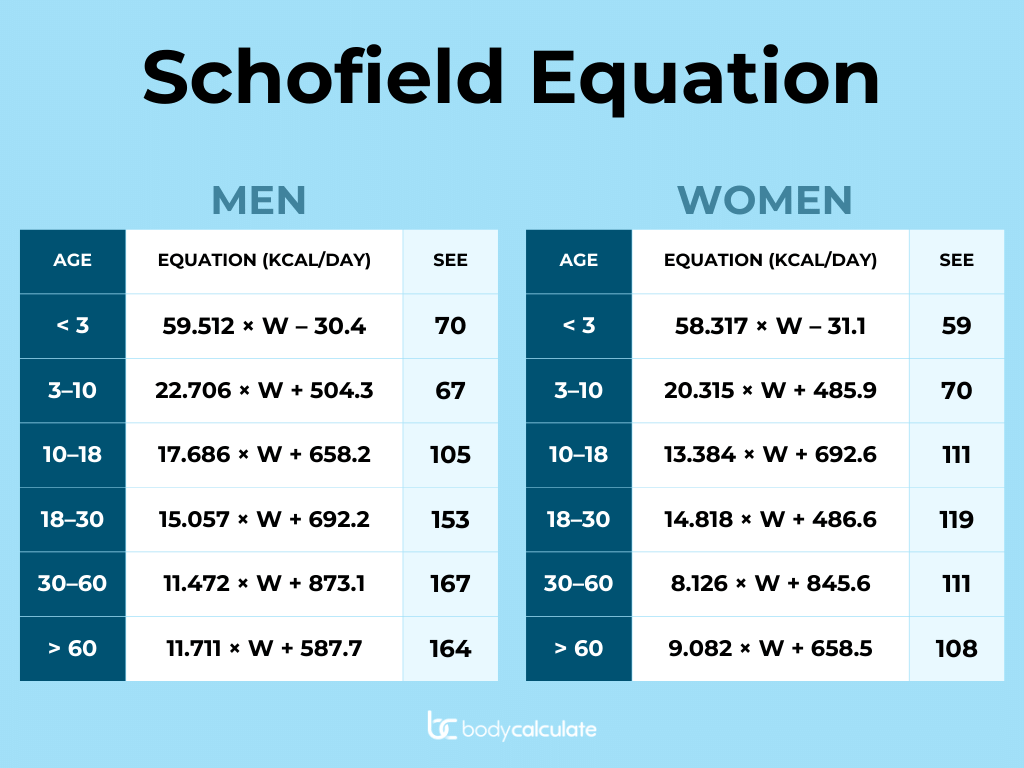The Schofield equations, introduced in 19851, are a set of formulas used to estimate Basal Metabolic Rate (BMR) based on body weight, age, and sex.
The World Health Organization (WHO) used the Schofield Equations for many years. The Schofield equations have now been superseded by the Mifflin St Jeor Equation and the Katch-McArdle Equation.
The Schofield equations are as follows:
The Schofield equations below are for calculating BMR and are expressed in calories per day and measured in pounds.
| Age: (Years) | BMR: (kcal/day) | SEE |
| Males | ||
| < 3 | 59.512 x (lb x 0.453592) – 30.4 | 70 |
| 3 – 10 | 22.706 x (lb x 0.453592) + 504.3 | 67 |
| 10 – 18 | 17.686 x (lb x 0.453592) + 658.2 | 105 |
| 18 – 30 | 15.057 x (lb x 0.453592) + 692.2 | 153 |
| 30 – 60 | 11.472 x (lb x 0.453592) + 873.1 | 167 |
| < 60 | 11.711 x (lb x 0.453592) + 587.7 | 164 |
SEE: Standard Error of the Estimate
| Age: (Years) | BMR: (kcal/day) | SEE |
| Females | ||
| < 3 | 58.317 x (lb x 0.453592) – 31.1 | 59 |
| 3 – 10 | 20.315 x (lb x 0.453592) + 485.9 | 70 |
| 10 – 18 | 13.384 x (lb x 0.453592) + 692.6 | 111 |
| 18 – 30 | 14.818 x (lb x 0.453592) + 486.6 | 119 |
| 30 – 60 | 8.126 x (lb x 0.453592) + 845.6 | 111 |
| < 60 | 9.082k x (lb x 0.453592) + 658.5 | 108 |
SEE: Standard Error of the Estimate
The Schofield equations were foundational and widely used for many years.
In large-scale studies where specific details, like the height of the study population, are unavailable, the Schofield equation can be used to calculate the BMR.
The Schofield equations have their own PAL values for calculating TDEE. These exclusive Schofield PAL values are derived from the average daily MET (Metabolic Equivalent of Task) value.
- Sedentary or light activity lifestyles:
- Sedentary occupation, little or no physical activity: 1.40 – 1.69 for men and 1.40 – 1.60 for women.
- Active or moderately active lifestyles:
- Occupations that involve standing or walking, but not strenuous physical activity: 1.70 – 1.99 for men and 1.61 – 1.85 for women.
- Vigorous or vigorously active lifestyles:
- Occupations that involve intense physical activity and heavy manual labor: 2.00 – 2.40 for men and 1.86 – 2.10 for women.
Schofield vs Mifflin-St Jeor Equation
Schofield Equation:
- Developed based on analyses of numerous studies conducted in the mid-20th century.
- The equation differs for different age groups and is separated by sex.
- Generally considered less accurate than more modern equations like Mifflin-St Jeor, especially for certain populations (e.g., obese individuals).
- Still used in some settings, especially in public health nutrition and dietetics.
VS
Mifflin-St Jeor Equation:
- Developed in 1990, based on modern data and is considered more accurate than older equations like Schofield for the general population.
- Includes variables for weight, height, and age, and also is separated by sex.
- Has been recommended by the Academy of Nutrition and Dietetics for use in clinical settings, particularly for estimating the energy needs of overweight and obese individuals.2
Example for a 30 year old, 6 foot, 300 pound, male.
Schofield Equation:
BMR = (15.057×136.08)+692.2
BMR = 2050.48+692.2
BMR = 2742.68 kcal/day
VS
Mifflin-St Jeor Equation:
BMR = 10×136.08+6.25×182.88−5×30+5
BMR = 1360.8+1143−150+5
BMR = 2358.8 kcal/day
Original Schofield Formulas
Men:
| Age | Equation (kJ/day) | SEE |
| < 3 | 249 × W – 127 | 292 |
| 3–10 | 95 × W + 2110 | 280 |
| 10–18 | 74 × W + 2754 | 441 |
| 18–30 | 63 × W + 2896 | 641 |
| 30–60 | 48 × W + 3653 | 700 |
| > 60 | 49 × W + 2459 | 686 |
Women:
| Age | Equation (kJ/day) | SEE |
| < 3 | 244 × W – 130 | 246 |
| 3–10 | 85 × W + 2033 | 292 |
| 10–18 | 56 × W + 2898 | 466 |
| 18–30 | 62 × W + 2036 | 497 |
| 30–60 | 34 × W + 3538 | 465 |
| > 60 | 38 × W + 2755 | 451 |
Men:
| Age | Equation (kcal/day) | SEE |
| < 3 | 59.512 × W – 30.4 | 70 |
| 3–10 | 22.706 × W + 504.3 | 67 |
| 10–18 | 17.686 × W + 658.2 | 105 |
| 18–30 | 15.057 × W + 692.2 | 153 |
| 30–60 | 11.472 × W + 873.1 | 167 |
| > 60 | 11.711 × W + 587.7 | 164 |
Women:
| Age | Equation (kcal/day) | SEE |
| < 3 | 58.317 × W – 31.1 | 59 |
| 3–10 | 20.315 × W + 485.9 | 70 |
| 10–18 | 13.384 × W + 692.6 | 111 |
| 18–30 | 14.818 × W + 486.6 | 119 |
| 30–60 | 8.126 × W + 845.6 | 111 |
| > 60 | 9.082 × W + 658.5 | 108 |

- Human energy requirements: report of a joint FAO/ WHO/UNU Expert Consultation. Food Nutr Bull. 2005 Mar;26(1):166. PMID: 15810802. ↩︎
- Academy of Nutrition and Dietetics. (2005). Evidence Analysis Library. “Resting Metabolic Rate: Best Practice for Clinicians.” Retrieved from the Academy of Nutrition and Dietetics Evidence Analysis Library. ↩︎
